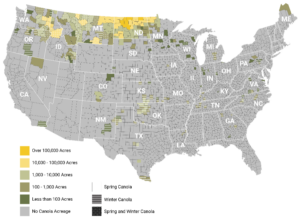We at Resaca Sun Feeds see canola as a highly beneficial crop. This crop has several benefits within a crop rotation and is used as a high-quality feed ingredient to be added to our feeds. Over the next few months, we’ll be outlining why canola is beneficial through a series of articles. It seems canola has gotten some negative publicity lately, so our goal is to show you why we grow canola and its benefits.

Approximately 2 million acres of canola is grown in the United States each year. Most of the canola is grown in the Pacific Northwest, Southern Great plains, and Northern Plains Canola meal. To the right is a map from the US Canola Association showing where canola was grown throughout the US in 2021. Moore’s Seed and Grain Farm grows canola in the winter for a number of reasons. Canola fits great into our crop rotation, improves our sustainability, and offers different market opportunities. Canola fits well in our crop rotation because it breaks the nematode and aphids cycle helping with insect control. Adding canola into our crop rotation also helps with weed pressure in the following years’ wheat crop. We see an increase in soybean yield following canola by 10% and an increase in wheat crop of about 10%. It increases the quality of the wheat by reducing. Canola has a 48-inch taproot, which helps break up the hardpan, and this helps us reduce tillage. The market scope is much larger for canola as well because it offers different market opportunities. The canola seed is taken to Resaca Sun Products where the oil is pressed out using an expeller press, resulting in a high protein, expeller pressed canola meal. The meal is used in several Resaca Sun Feeds’, especially in our corn and soy free products. Canola oil is used for livestock feed, cooking oil, or industrial uses.
